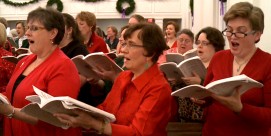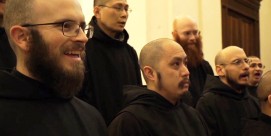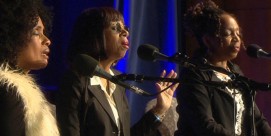In This Episode << SLIDE LEFT TO SEE ADDITIONAL SEGMENTS
William Romanowski Extended Interview
Read more from Jeff Sheler’s interview with William Romanowski, professor of communication arts and sciences at Calvin College:
On evangelicals and mainstream culture:
Evangelicals came to believe that the paramount, if not sometimes the only thing that distinguishes Christian popular art from mainstream products is what I call its confessional content. It has to make an explicit statement of faith. …

On popular music:
For evangelicals the lyrics are really important. The music doesn’t matter at all. Contemporary Christian music employs a myriad of musical styles: country, rap, rock, whatever, as long as the lyrics are specifically about Jesus, about faith in God. So in many ways they use popular music styles as just a vehicle of evangelism. And evangelism is really key to understanding evangelical popular culture. A product has to be about the business of bringing people into the faith. That gives us a lot of insights, I think, into the dynamics and tensions that exist in evangelical popular culture.
On singer Amy Grant and crossing over:
When she began to cross over into the mainstream market, that raised questions: Are confessional lyrics really what evangelical music is all about? And so when Amy Grant began to sing songs that were not explicitly religious, her fans just went ballistic. They were very critical of her, saw her as selling out. In one sense, if it’s the rule for Christian music that the lyrics have to be explicitly religious, then to do other things is selling out. In another sense, you can also argue that Amy Grant was beginning to transcend or get beyond what was a pretty limited idea of what Christian popular art ought to be.
On relating to mainstream popular culture:
Evangelicals engage mainstream popular culture on their own terms. … Much evangelical criticism of mainstream culture is along the lines of sex, profanity, and violence, and I would suggest that that is the order of priority. There’s not a lot of concern with aesthetic features or how a film might communicate a particular worldview. Nor would I say there’s much interest in features like depth of character, consistency of story, or things like that. They are more concerned about the very specific moral vision that is in a film. Sometimes I would think they promote things that are not necessarily consistent with a biblical vision. Most contemporary Christian music is generally seen as mediocre in many respects in terms of mainstream. There is no contemporary Christian artist on the lines of a Bruce Springsteen, for example. Is it all bad? No. A lot of it, because it’s so explicit and so intent upon communicating a message, turns it into religious propaganda. It seems to me that the best popular artworks don’t say something as much as they display it; they don’t tell you something, they show it to you. Cultural values, beliefs, ideals, and assumptions are really woven into characterizations and into story lines, and in that way they communicate a worldview. But simply to say what it is is more sermonic, and in that sense it doesn’t make as good art as the kinds of things we see happening in the mainstream culture. Here’s an example. A critic wrote about … the LEFT BEHIND film an immediate disclaimer: “This is not to denigrate the religious beliefs that inform the film LEFT BEHIND, but to talk about the hilariously bad manner in which they are communicated.” I think the critic is getting at something there. It’s not that you cannot bring a religious perspective into media productions. But how do you do that? Do you do in terms of consistency of story, depth of character, dialogue that sounds real? I think a lot of evangelical popular art has not been so interested in that as in making sure there is a clear presentation of the gospel there. In that sense it becomes religious propaganda and not so much really talking about art and being nuanced.
On the impact of crossover:
Contemporary Christian musician executives wanted to reach that 46 percent of Americans that went to church regularly, but only 10 percent of them shopped in Christian book and record stores, which is where Amy Grant and other contemporary Christian music artists primarily sold their records. It was really trying to expand their audience among churchgoers. But in the midst of the crossover, you have Amy Grant on the one hand trying to get beyond just dealing with religious themes to talk about other areas of life. But when she did that, she ends up writing just wholesome love songs. How does that affect mainstream culture? It alerted mainstream culture that there is a family market out there. …
Popular art reflects the culture that it helps to create. In many respects, by having evangelical artists in the media producing records, television programs, motion pictures that are very specifically about a religious group, that says to people out there sitting in the seats, “I exist. I see myself in the media.” I think it has created a greater awareness among evangelicals of themselves as a community, and probably has alerted mainstream producers that here is a particular community that can be exploited for commercial purposes. So all the major gospel record companies in the early 1990s were bought by media conglomerates. They became just one part of the huge entertainment conglomerates, aimed specifically at that evangelical market.
On megachurches:
There is a connection historically between contemporary Christian music and the megachurch movement. By bringing contemporary music into the worship service, it also brought all the cultural baggage that comes along with it. So contemporary Christian music, even though it might have grown out of purposes like evangelism and worship, gets used in an entertainment setting. Conversely, it brings that entertainment setting into the church. A lot of critics ask, has worship become entertainment? It professionalizes worship in a certain sense.
On popular culture and personal morality:
Contemporary Christian musicians see themselves as ministers. In many regards, then, they are treated as a minister. They are held to a certain kind of moral standard. There was a lot of uproar with the divorces of Sandy Patty and Amy Grant in the contemporary Christian music industry. People make them idols in many respects and perhaps put them on a pedestal and hold them up higher than they ought to. Evangelicals are very concerned about personal morality. Amy Grant could be making spectacular music, but if they don’t think that her life is right with God, evangelical listeners will not buy her records. In fact, there were radio stations that [said] they would not play her records or stores that would not stock them. So your personal life can have a significant impact on the business side of it as well.
On maintaining boundaries:
I advocate cultural engagement, but I’m not advocating cultural accommodation. I’m advocating going in with a Christian perspective and looking and thinking about things along those lines. The kind of evaluation I might talk about in popular art is not simply its confessional appearance, or does it have religious imagery or ministers, or are people praying in it. But what is the underlying vision, the cultural landscape that informs this work of art, and how might Christians think about that? I see it more as entering into a cultural dialogue, where people talk about different visions of life that are manifested in television programs, films, etc.
On media hostility:
I think the mainstream media is most interested in profit making, and if they think they can make money off religious groups, then I think they will make money off religious groups. Are they particularly hostile? Sometimes they are. Sometimes I think people in mainstream media don’t understand Christian values and how people in religious communities think. And because of that, they just don’t know how to deal with them. A lot of times they don’t think of religion as significant in life, and so they don’t cover it as well. It’s more complicated than that. But there are different perspectives at work. …
On THE PURPOSE-DRIVEN LIFE:
That book probably got at a key question for evangelicals, and that is if you believe that Christ is the Lord of all of life, then how am I to be faithful as a Christian in all of life? How can I be faithful in terms of business, in how I think about education, politics, popular arts? How do I apply faith to everything I do?
On movies:
Writers talk about Hollywood being the place where Satan has his throne, and movies were part of the worldly amusements that many Christians just simply boycotted. Church denominations did not allow their members to go to those. So evangelicals got into filmmaking later. But the same sort of tensions exist. … How do you reach the broad market with a very particular religious message, especially one meant to be forthright and explicit? That’s difficult to do, and I think that shows a weakness in the evangelical model for popular art. Popular artworks tend to affirm what people already believe rather than get them to think about new ideas; not that it can’t do that, but most people go to a motion picture and leave wanting to be affirmed in their view of life. When popular artworks got outside of that evangelical subculture, they had a hard time finding an audience in mainstream culture. That remains the case with films today. Some films like LEFT BEHIND and THE OMEGA CODE have been successful in the evangelical market but have not done well in the general theatrical release. A lot of evangelical filmmakers struggle with that tension, how to reach a broad audience. But at the same time, some way or another, their work has to have some explicit religious content in order to be Christian. That’s a tension they are working to overcome.
On THE PASSION OF THE CHRIST:
Here’s a film by a major filmmaker dealing with Christ’s Passion, an explicit religious film that would have great appeal among evangelical Christians. The Gibson film might identify that religious market, but the question is, for what? For more specific religious films. So we are going to get THE GREATEST STORY EVER TOLD again and again and again. And if history is any marker on this, we will have a couple films that might do incredibly well, but most of them will not be very successful. It’s like riding a wave. I’m more interested in developing a kind of tradition seeing Christians as an interpretive community that looks at popular artworks from a matter of a faith perspective, and looks at them along those lines having some respect for other faith perspectives. If you want to do films and music that’s evangelistic for other people, you should be open to them doing evangelism with you. … I’m arguing more about cultural dialogue, where people can examine an artwork for what it says about life, about human beings and their relationship to God and the world and particular issues, and how might we think about those issues from a Christian perspective.
On evangelicals in mainstream culture:
They exist in a hostile world and are defending their faith, particularly in personal kinds of ways, but at the same time they want control of that culture. They want their values to be the supreme ones. Largely, evangelicals’ popular art is not having a major impact on mainstream culture. … In their model of using popular art to express very specific religious convictions, I don’t think you see that taking root in the mainstream popular culture. In fact, I think you see the opposite happening. When evangelical artists get into that mainstream culture, they have to figure out ways to tell stories that are not explicitly religious. How do you do that? I’m suggesting rather than being sermonic about it, that you weave that vision into storytelling, into characterizations, into lyrics, and into musical style. Evangelicals need a better concept of art. For evangelicals, when it comes to popular art, faith is the issue; it’s all about expressing faith. I would suggest they use faith more as the context for doing popular art. You use views of human beings, for example, that are more ambiguous: that people are both good and evil and how you work through that, or trying to understand how we see God at work in our lives — telling stories that would explore those kind of things, as opposed to personifying God or making God into what one writer called some kind of magical outside assistance that gives self-reliant people a little boost along the way. I would suggest trying to really think about how we would work a Christian faith vision into a kind of cultural landscape that would inform storytelling, that would produce a whole different kind of Christian popular art that I think would be more interesting, more dramatic, and also would find a market in the mainstream culture.







